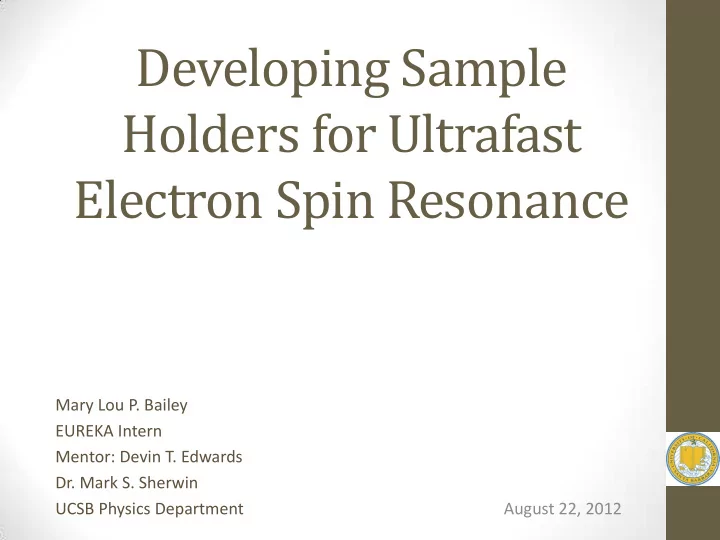

Developing Sample Holders for Ultrafast Electron Spin Resonance Mary Lou P. Bailey EUREKA Intern Mentor: Devin T. Edwards Dr. Mark S. Sherwin UCSB Physics Department August 22, 2012
What is ESR Spectroscopy? • Investigates unpaired electron spins • Biology: Structures of protein complexes ProteoRhodopsin Hexamer
Electron Spin Resonance • Electrons spin-up or spin-down • Excitation causes precession Spin-up and spin-down electrons B
What Makes ESR at UCSB Unique? • Powered by Free Electron Laser (FEL) • Power 100,000x greater than a typical ESR experiment • Frequencies above 100 GHz • Strong Magnet • 12.5 Tesla = 200,000x magnetic field of the earth Advantage: High power allows measurements of very rapid decaying spins UCSB FEL
Studying Biological Samples ESR signal out (to FEL pulse in detector) Sample in here Sample Holder Waveguide
Sample Holders Reflect Pulse Free Induction Decay • Reflections interfere with (ESR signal) decaying spin signal • Must turn detector on 80 ns after pulse shot • Goal : Reduce “dead - time”
Making New Sample Holders CAD 2D Sketches Machine Shop Drill Rod Blade Lathe Teflon and Rexolite rods Labels in inches x10
Machined Sample Holders Original Shape Teflon Cylindrical Rexolite Cylindrical New Design Teflon Cone Rexolite Cone
Testing with the FEL • Raw data: Amp. v. time • Fourier Transform data to look at prominent frequencies • FEL frequency = 500 MHz (mixed down) Before Fourier Transform (Original Cylindrical Teflon) (a. u.) Reflections from FEL pulse Amplitude FEL pulse 0 20 40 60 80 100 Time (ns)
Comparing FEL Pulse Reflections • Teflon reflects much more than Rexolite 0.00264 0.00264 Amplitude (a. u.) Amplitude (a. u.) 0.00198 0.00198 Amplitude 0.00132 0.00132 0.00066 0.00066 0.00000 0.00000 0 200 400 600 800 0 200 400 600 800 Frequency (MHz) Frequency (MHz) Original Cylindrical Teflon Original Cylindrical Rexolite
Reflections from the Double Cone • Two prominent peaks • Rexolite looks somewhat better 0.00264 0.00264 Amplitude (a. u.) Amplitude (a. u.) 0.00198 0.00198 Amplitude 0.00132 0.00132 0.00066 0.00066 0.00000 0.00000 0 200 400 600 800 0 200 400 600 800 Frequency (MHz) Frequency (MHz) Double Cone Teflon Double Cone Rexolite
Comparing Reflections from all Four Holders • Integrate peaks • Greater area = more reflections Area Under FEL Reflection Peaks 450000 400000 350000 300000 Area (a. u.) 250000 200000 150000 100000 50000 0 1 2 3 4 Cylindrical Teflon Cylindrical Rexolite Double Cone Teflon Double Cone Rexolite
Conclusions and Future Tests Conclusions: • Rexolite is a better material than Teflon • Continue using the cylindrical design for now Further Testing: • Add sample to the holders, measure decay of spins • Look for a decrease in “dead - time”
Acknowledgements • Devin T. Edwards • Dr. Mark S. Sherwin • Tyler Shropshire • Dr. Arica Lubin
Recommend
More recommend